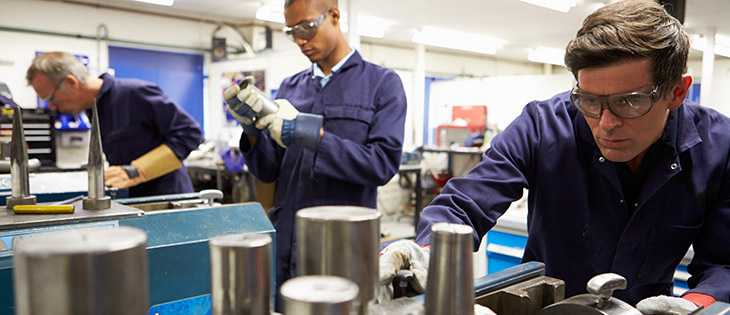Shaping the Manufacturing Workforce with Apprenticeships
Modern apprenticeship programs are gaining traction as they help grow the talent pool and meet the escalating demand for job-ready candidates.

Midsize manufacturers and supporting groups across the country are increasingly addressing workforce challenges through apprenticeships.
Thanks in part to financial assistance from government, private sources and businesses themselves, companies are adopting modern apprenticeship programs to remedy the supply and demand imbalance in manufacturing. These initiatives are increasing the pool of skilled workers and creating a pipeline of higher-quality talent in the trades.
“Because apprenticeship training is so effective, we’re experiencing a renewal of apprenticeships in the United States,” says Charlotte Weber, director and CEO of the Robert C. Byrd Institute, which supports economic development in the mid-Atlantic region.
In 2015, RCBI received a $4.9 million award from the U.S. Department of Labor, as part of the American Apprenticeship Initiative, to expand its training model for technologically advanced manufacturing nationwide.
“Industry and workers are benefitting equally from this proven method of closing the skills gap in today’s new manufacturing—a resurgent industry that continues to drive our economy,” Weber says.
That’s encouraging for the manufacturing sector, particularly after sobering findings from Deloitte and The Manufacturing Institute published in 2015. After analyzing data from the U.S. Bureau of Labor Statistics and a Gallup survey, Deloitte and TMI determined that 3.5 million manufacturing jobs will need to be filled in the next decade—and that 2 million of those jobs will remain open. An estimated 2.7 million jobs are likely to be needed as a result of retirements by members of the existing workforce, and economic expansion is expected to create 700,000 new manufacturing jobs. Yet only 1.4 million are likely to be filled by 2025, a sharp increase from 2011, when 600,000 jobs went unfilled because of the skills gap.
Every job in manufacturing creates another 2.5 new jobs in local goods and services. For every $1 invested in manufacturing, another $1.27 in additional value is created in other sectors.
Source: National Association of Manufacturers
The implications are significant. Every job in manufacturing creates another 2.5 new jobs in local goods and services. For every $1 invested in manufacturing, another $1.27 in additional value is created in other sectors, according to the National Association of Manufacturers.
Experts and business leaders say several factors have contributed to the widening skills gap in manufacturing. Many skilled workers are aging and retiring, creating vacancies and removing institutional knowledge from the industry. Meanwhile, technology is progressing quickly, but the manufacturing workforce largely lacks the science, technology, engineering and math skills needed to keep pace.
There’s a talent pipeline problem, too. Young people are often unaware of, or uninterested in, skilled labor jobs. Many of today’s job seekers—including college graduates—are leaving school without marketable skills or practical work experience. Without highly qualified workers, it’s difficult for businesses to meet customer demands, maintain or increase production levels, and implement new technology to drive productivity gains.
The Apprenticeship Advantage
Many businesses are finding that the most cost-effective way to attract skilled employees, develop their workforce and meet business goals is through company-sponsored apprenticeships. These programs—which harken back to the vocational training of the mid-20th century’s industrial peak—integrate classroom learning with on-the-job training while affording participants a paycheck.
Most programs run for two to four years, during which time an apprentice acquires new skills and industry credentials under a trained mentor. One or two days each week are dedicated to classroom instruction at a local community college or technical school.
Graduates of these apprenticeship programs become medical technicians, welders, electricians, machinists, robotics programmers, plumbers and computer technicians, among other roles. They often enjoy above-average incomes and job security, says Lucinda Curry, director of the Robert C. Byrd Institute’s Apprenticeship Works program. Graduates of registered apprenticeships earn an average of $59,900 per year, according to Department of Labor data, higher than the median annual wage for all occupations, which was $37,040 in 2016.
The programs’ value extends to the apprentices, who gain access to a career path, as well as employers, which benefit in myriad ways, including stemming the loss of expertise that leaves companies as older workers retire.
The programs “allow experienced employees to serve as journey workers, passing on what they know to their fellow employees—helping companies retain institutional knowledge,” Curry says. “Apprenticeships also foster loyalty among the workforce, boosting retention and reducing turnover.”
The individualized training offered through apprenticeships can reduce potential liabilities and costly inefficiencies for manufacturers. “Skilled workers make fewer mistakes and have fewer accidents, making companies safer and more productive,” Curry notes.
“Industry and workers are benefitting equally from this proven method of closing the skills gap in today’s new manufacturing—a resurgent industry that continues to drive our economy.”
CHARLOTTE WEBER
Director & CEO, Robert C. Byrd Institute
It Takes an Ecosystem
To close the manufacturing skills gap, businesses must build a skilled and loyal workforce. But they can’t do it alone. Overcoming a tight labor market takes a collaborative effort of manufacturers, educators, communities and government, says Noel Ginsburg, who spent 38 years as a manufacturing entrepreneur and is the founder and CEO of Intertech Plastics.
In 2016, Ginsburg founded CareerWise, a nonprofit that coordinates apprenticeships among businesses, students and educators in Colorado. The organization aims to create more than 20,000 apprenticeships across multiple business sectors during the next 10 years.
Ginsburg sees a role for schools in establishing guidelines around key competencies, with input from industry. Education institutions also have a part to play in showing parents that apprenticeships can lead to well-paying jobs or higher education opportunities for their children.
Meanwhile, partners in the community can contribute to programs’ success through funding and other supporting functions. CareerWise has received more than $13 million in cash and in-kind resources from Bloomberg Philanthropies, JP Morgan Chase, Daniels Fund, Markle Foundation, Mile High United Way and other groups.
“The burden of educating the state’s workforce falls on the schools, but it should be a joint effort among businesses, schools and communities,” says Ginsburg, who is addressing manufacturing workforce issues as part of his campaign for governor of Colorado.
Forty companies participated in CareerWise’s first year of operation, and they’re making three- to four-year commitments, according to Ginsburg.
“Our business partners are hiring and training youth apprentices to build their future workforce,” he says.
Bringing in the Feds
Support from the federal government is another essential piece in solving the workforce puzzle. President Donald Trump in June signed an executive order to substantially increase the number of U.S. apprenticeships from their current level of 500,000 by doubling the amount of federal funding for such programs.
Building a new apprenticeship program from scratch can be difficult and costly. But manufacturers working with Apprenticeship Works receive services at a substantial discount, thanks to the 2015 Department of Labor grant. Apprenticeship Works offers consulting services to develop and implement the apprenticeship program. It also provides pre- and post-assessment of employees’ knowledge and skills, and access to training materials.

Some programs work with a local community college while others rely on online courses. Regardless of the format, all apprenticeship programs are advised to register with the DOL, says Marian Merritt, who leads industry engagement for the National Initiative for Cybersecurity Education, part of the U.S. Department of Commerce’s National Institute of Standards and Technology.
Registration enables the employer and apprentice to access a slew of federal benefits, including assistance stemming from the GI Bill for military veteran participants. It also makes apprentices eligible to receive a valuable, recognized credential when they complete their program.
Marlon Bailey, president and CEO of privately held manufacturer ART Metals Group, is pleased so far with his company’s participation in Ohio’s two-year Mechatronics Apprenticeship Program Partnership, or MAP2, which focuses on advanced manufacturing training in the state. A second-year apprentice at the company has begun to take on larger projects, and ART Metals recently added another apprentice through the program.
“We know our tool room is going to have many retirements over the next five years. So we have to grow our own workforce,” Bailey says. “People from this apprenticeship will become our technical operations leaders and, eventually, management leaders.”

Heather Swink, M.A., CAE, is a freelance writer and editor in the Chicago area serving associations.


